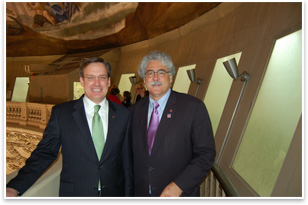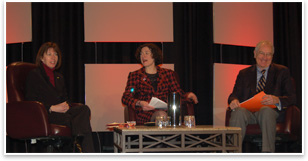Component Leaders Take Rebuild and Renew to Capitol Hill
by Douglas E. Gordon, Hon. AIA
Executive editor
 Summary: More than 300 AIA component presidents, presidents-elect, and executives gathered February 5 to take the AIA Rebuild and Renew message to their representatives and senators in Washington, D.C. Conferees gathered at 7:30 a.m. for inspiration from Rep. Earl Blumenauer, Hon. AIA (D-Ore.); Acting Architect of the Capitol Stephen Ayers, AIA; President Marvin Malecha, FAIA; First Vice President/Grassroots Chair George Miller, FAIA; and a panel of AIA Executive Vice President/CEO Chris McEntee, American Society of Landscape Architects EVP/CEO Nancy Somerville, Hon. AIA, and American Planning Association Executive Director/CEO Paul Farmer. Summary: More than 300 AIA component presidents, presidents-elect, and executives gathered February 5 to take the AIA Rebuild and Renew message to their representatives and senators in Washington, D.C. Conferees gathered at 7:30 a.m. for inspiration from Rep. Earl Blumenauer, Hon. AIA (D-Ore.); Acting Architect of the Capitol Stephen Ayers, AIA; President Marvin Malecha, FAIA; First Vice President/Grassroots Chair George Miller, FAIA; and a panel of AIA Executive Vice President/CEO Chris McEntee, American Society of Landscape Architects EVP/CEO Nancy Somerville, Hon. AIA, and American Planning Association Executive Director/CEO Paul Farmer.
Energy production needs to be more efficient, Blumenauer said. And making that change requires a combined effort; a meeting of the minds. It is also a political process, he advised, which includes the commitment to contribute to ArchiPAC, the AIA’s political action committee. To that end, the AIA has joined with 26 other planning, design, and construction organizations to show Congress that the design community has a joint commitment, affirmed AIA Vice President for Government Affairs Paul Mendelsohn.
 In a panel discussion following Ayer’s remarks, McEntee noted the urgency of dedicating stimulus money to infrastructure development, both “shovel ready” and projects still in the planning stages, including transit and community planning. With the population of the U.S. projected to grow 50 percent by 2050, centered in metropolitan areas, the U.S. is facing a need for $1.6 trillion in infrastructure improvements. Rebuild and Renew is a necessary first step toward that goal. In a panel discussion following Ayer’s remarks, McEntee noted the urgency of dedicating stimulus money to infrastructure development, both “shovel ready” and projects still in the planning stages, including transit and community planning. With the population of the U.S. projected to grow 50 percent by 2050, centered in metropolitan areas, the U.S. is facing a need for $1.6 trillion in infrastructure improvements. Rebuild and Renew is a necessary first step toward that goal.
As a coalition, the Rebuild Renew partners need to educate the public on every level of energy production and efficiency, from better batteries to the value of planning, Farmer added. Today, people believe that the fewer homes per acre, the better. But, he said, in Pittsburgh a person living downtown consumes one-ninth the commuting energy as someone living nearby in the suburbs. The public has to understand “meaningful density,” he said, and turn around the federal policy of supporting highways over mass transit, which only encourages sprawl. As a group, designers need to move government policies from the old mindset of filling wetlands to the new one of protecting them.
In concert, Somerville spoke of the ASLA Sustainable Sites Initiative, working with the U.S. Green Buildings Council to create a point system similar to LEED® where points are assessed for landscape features that conserve water and contain carbon emissions.
Component executives adjourned to take the message to the Hill—this year going green and taking the subway instead of buses. |


 Summary:
Summary: In a panel discussion following Ayer’s remarks, McEntee noted the urgency of dedicating stimulus money to infrastructure development, both “shovel ready” and projects still in the planning stages, including transit and community planning. With the population of the U.S. projected to grow 50 percent by 2050, centered in metropolitan areas, the U.S. is facing a need for $1.6 trillion in infrastructure improvements. Rebuild and Renew is a necessary first step toward that goal.
In a panel discussion following Ayer’s remarks, McEntee noted the urgency of dedicating stimulus money to infrastructure development, both “shovel ready” and projects still in the planning stages, including transit and community planning. With the population of the U.S. projected to grow 50 percent by 2050, centered in metropolitan areas, the U.S. is facing a need for $1.6 trillion in infrastructure improvements. Rebuild and Renew is a necessary first step toward that goal.